You are using an out of date browser. It may not display this or other websites correctly.
You should upgrade or use an alternative browser.
You should upgrade or use an alternative browser.
unURBAN Adventures - Alaska to Argentina to AFRICA!
- Thread starter unURBAN
- Start date
Totally awesome!!! Now I have to turn around and go back...

YukonMontanaTannerTrapper
Explorer
Congratulations on your summit. Can't wait for my turn...............
JohnIndenver
New member
Your last picture is now my desktop picture. A whole bunch of others have done the same with this and/or other of your great shots.....
RTT Annex
Hey hey unURBAN,
Thanks for such an awesome trip report and photos. We are planning to do this trip in 2 to 3 years, and you guys are definitely increasing the excitement level!!
From your Pico photos, I see you have the Howling Moon, with the annex. We have a smaller Howling Moon without the annex, which was great for Australia and Africa with 2 people. But now we have a kid, so Alaska to Argentina with 3 of us means I have been considering an upgrade.
How often do you use the annex? Do you like it? Recommend it? Do you use it for privacy, for cooking, for eating and reading? Once the RTT tent is in place, how long does the annex take to set up?
Have fun!
Chris.
Hey hey unURBAN,
Thanks for such an awesome trip report and photos. We are planning to do this trip in 2 to 3 years, and you guys are definitely increasing the excitement level!!
From your Pico photos, I see you have the Howling Moon, with the annex. We have a smaller Howling Moon without the annex, which was great for Australia and Africa with 2 people. But now we have a kid, so Alaska to Argentina with 3 of us means I have been considering an upgrade.
How often do you use the annex? Do you like it? Recommend it? Do you use it for privacy, for cooking, for eating and reading? Once the RTT tent is in place, how long does the annex take to set up?
Have fun!
Chris.
Spectacular! Great report and photos, thanks for taking the time to share. Any plans for other peaks during your trip?
Well.... There is this little volcano down in Guatemala that they say is the highest peak in CENTRAL America..... We'll see if we drive by it on our way south.
And we do hope to climb some peaks in South America, but no specific plans yet.
E&M
That's funny I'm using that one for a wallpaper too. Let hope we don't get charged:wings:
HEY! Did I just see a business oportunity pass me by here.....?????
Don't worry, guys. We feel honored to be "published" locally around the world!
E&M
Oh! And one question:
Does anyone here have experience with camping in Guatemala? We now use Church's book for camping in Mexico, and they mention a couple of sites for Guatemala and Belize, but not many. We are looking into driving a route between Hue-hue and Coban, and possible even further north if we find desent roads and driving directions (and places where we can stay...).
We have found descriptions from dare2go.com and 99daystopanama.com on the internet with descriptions of some places to stay. This is great info for pan-am travellers! But the more info the better! So if anyone has places to recommend it would be most appreciated.
E&M
Does anyone here have experience with camping in Guatemala? We now use Church's book for camping in Mexico, and they mention a couple of sites for Guatemala and Belize, but not many. We are looking into driving a route between Hue-hue and Coban, and possible even further north if we find desent roads and driving directions (and places where we can stay...).
We have found descriptions from dare2go.com and 99daystopanama.com on the internet with descriptions of some places to stay. This is great info for pan-am travellers! But the more info the better! So if anyone has places to recommend it would be most appreciated.
E&M
Last edited:
Rain, Palenque and Chiapas
After about a week up in the mountain we drove from Tlachichuca at 2700 meters where it was all dry and yellow, and got down on Mex 150 and continued to drive down and down. The landscape changed a lot with the altitude, and after a couple of hours driving were we at 100 meters and driving next to sugarcanes and lagoons in 34 degrees Celsius. It was amazing to suddenly be in the tropics and jungle, it was so green.
First stop in the lowlands was Catemaco in the state of Veracruz. One day we drove out to have a look at the cost at the Mexican Gulf.
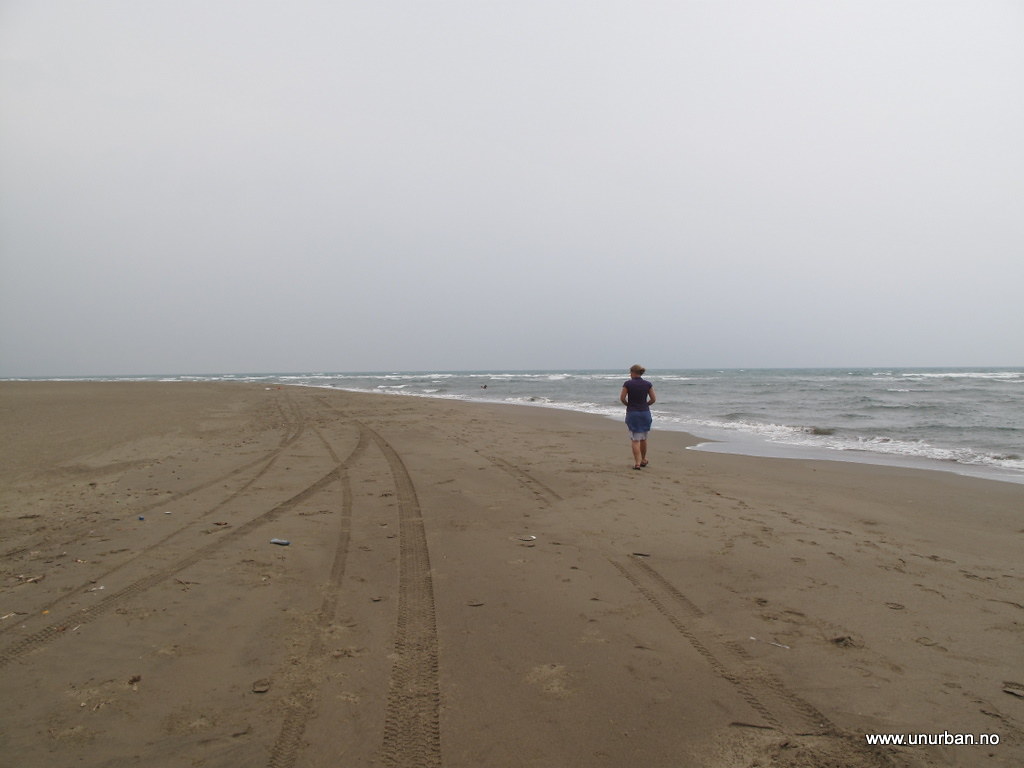
There we found some really nice beaches, but the weather was gray with a drizzle. Not so good for beach life.
During the night we learnt why this area is so green. Rain, rain and a lot of rain, so the next day was a good day to leave Catemaco. We decided to drive the road on the east side of the lake and not the normal one on the west, but 40 minutes into the drive it was full stop.

Because of all the rain, a river that was not marked on our map was flowing over the river banks and a bridge. If we really had to, we could probably have crossed, but thinking about the rivers that was marked on our map further down on this road, we decided to turn around so that we wouldn’t be “trapped” between rivers. The whole drive from Catemaco to Palenque, about 460 km, it continued to rain.

In the Lonely Planet we could read that Palenque is “in an area that receives the heaviest rainfall in Mexico”.
After one more day with rain the rain god finally decided that it was enough and we could explore the Maya ruins in Palenque.
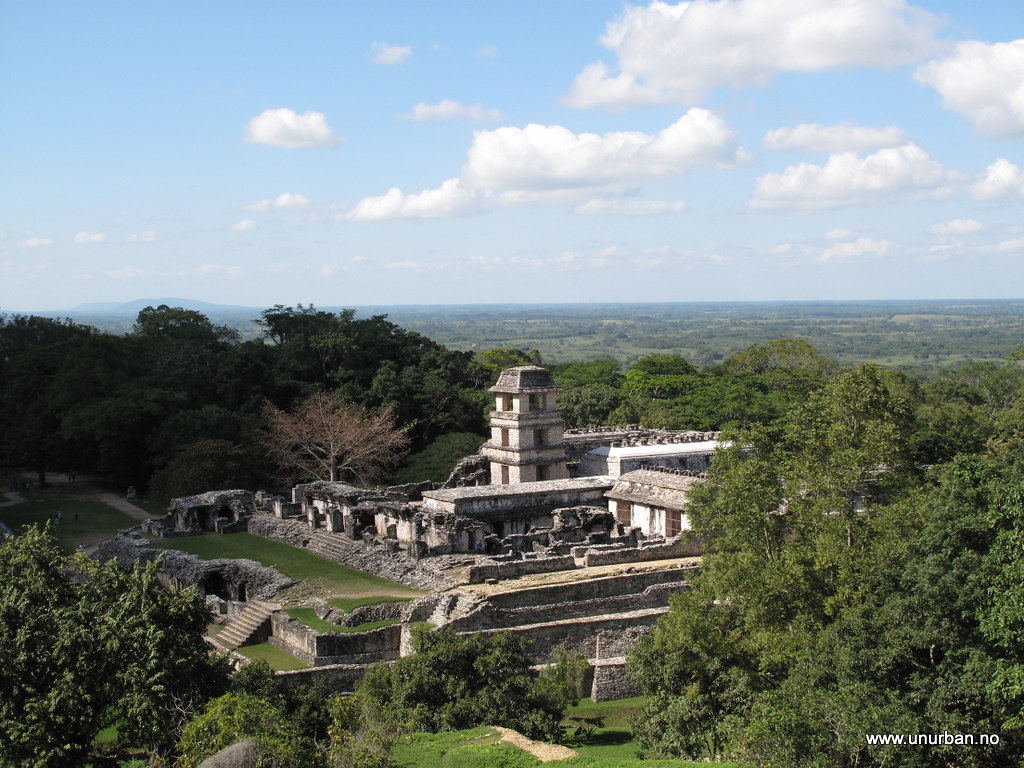
Palenque flourished from 600 to 800 AD and is known for its fine stucco bas-reliefs and inscriptions.
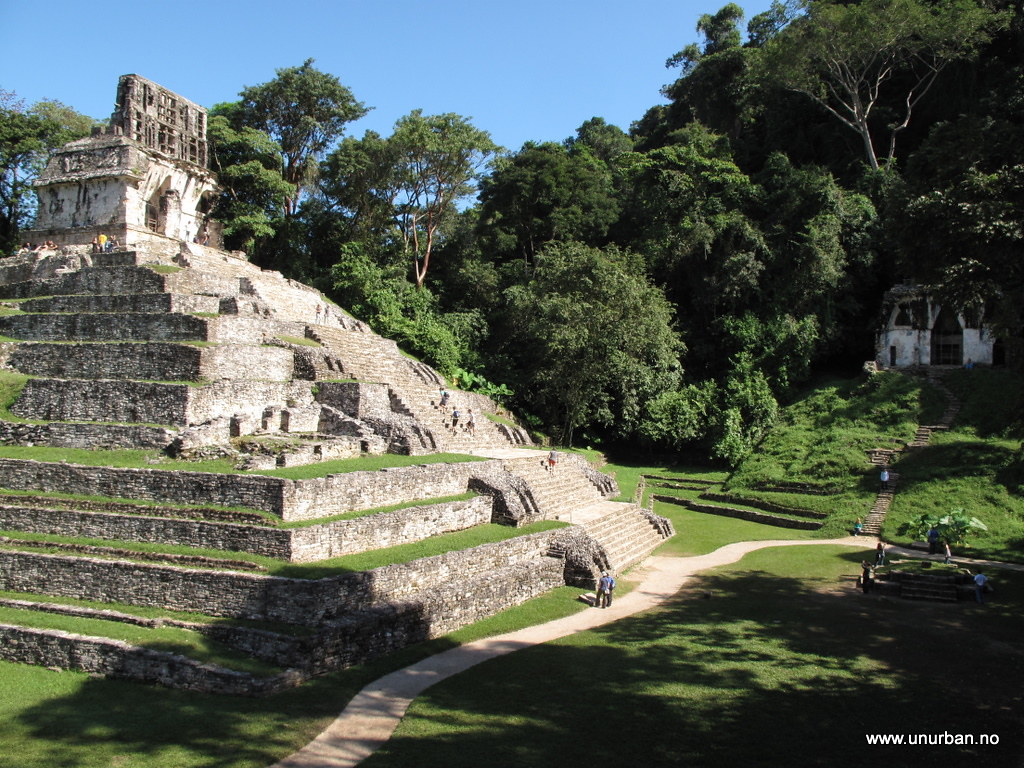
After exploring the nicely restored ruins,
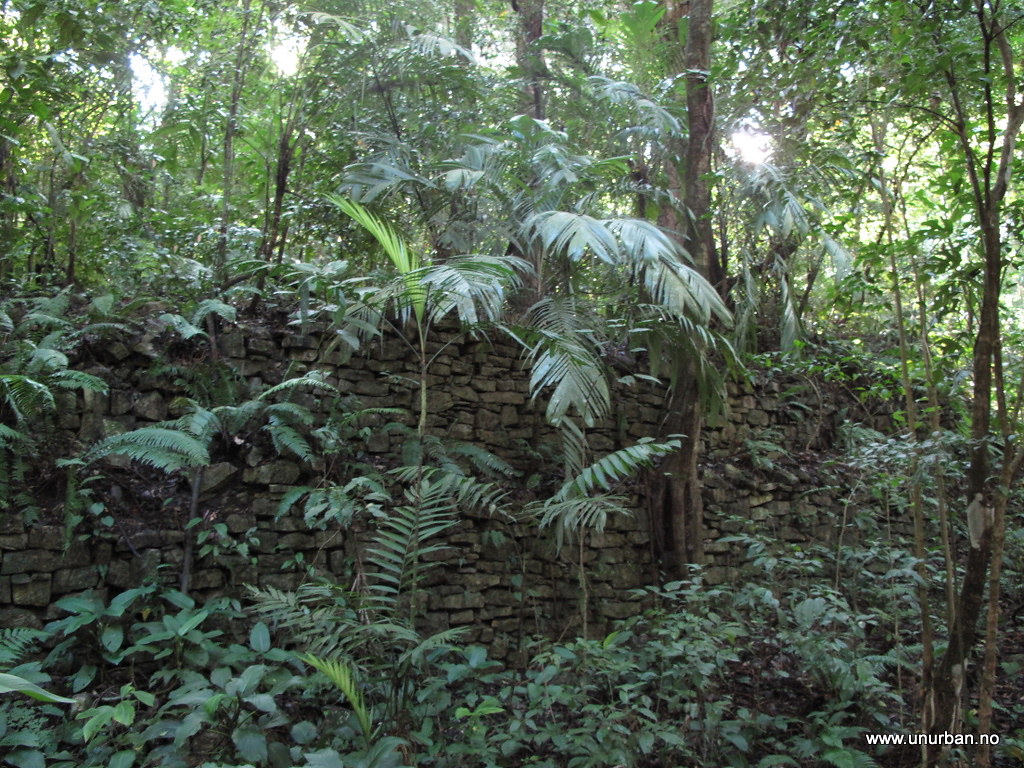
we just had to follow a path out in the jungle to see if we could find the parts of the ruin city that are still covered by jungle.
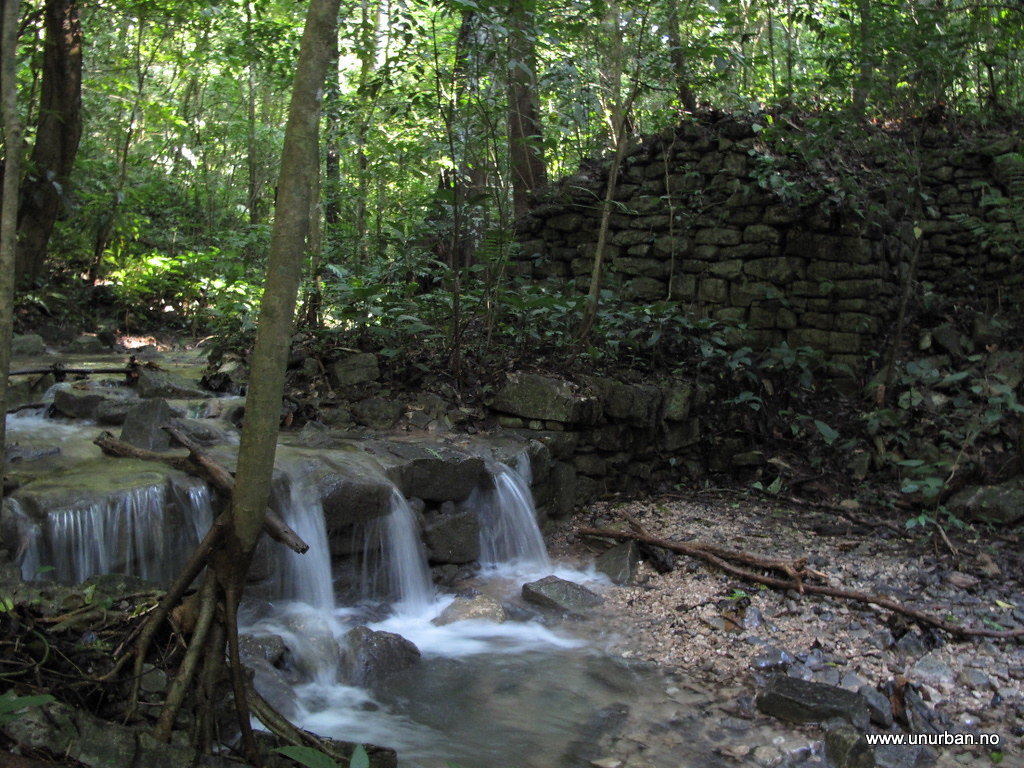
From Palenque we wanted to drive 225 km further south in Chiapas to San Cristóbal de Las Casas. About 40 km south of Palenque we had to stop behind some cars that had stopped in the road in front of us. Then we saw that the locals, kids, teenagers, men and women, had put homemade spike roadblocks across the road in front of the cars, and they refused to remove them until a “toll” was paid. First they wanted 100 pesos to let us pass, then we saw a Mexican car paying 50 pesos and they were happy with us paying 50 pesos too. Then the spike roadblock was pulled to the side and we could pass. Chiapas style toll road….. After a few more kilometers we saw that a string was pulled across the road and we were thinking “oh no, not again”. Then we saw that a middle age women is using this trick to stop the cars to sell bananas. We did not feel the urge for bananas at this moment, so she let us pass.
We realized it was Saturday and the road between Palenque and Agua Azul is probably full of tourists so we’re guessing the locals use the opportunity to take in some extra money on the weekend. Chiapas is one of Mexico’s poorest states and about a quarter of the inhabitants are Maya. The Zapatistas are fighting for indigenous rights.
The major attraction along the road is the Agua Azul Waterfalls, and we had read that this tourist destination was run by the local people.
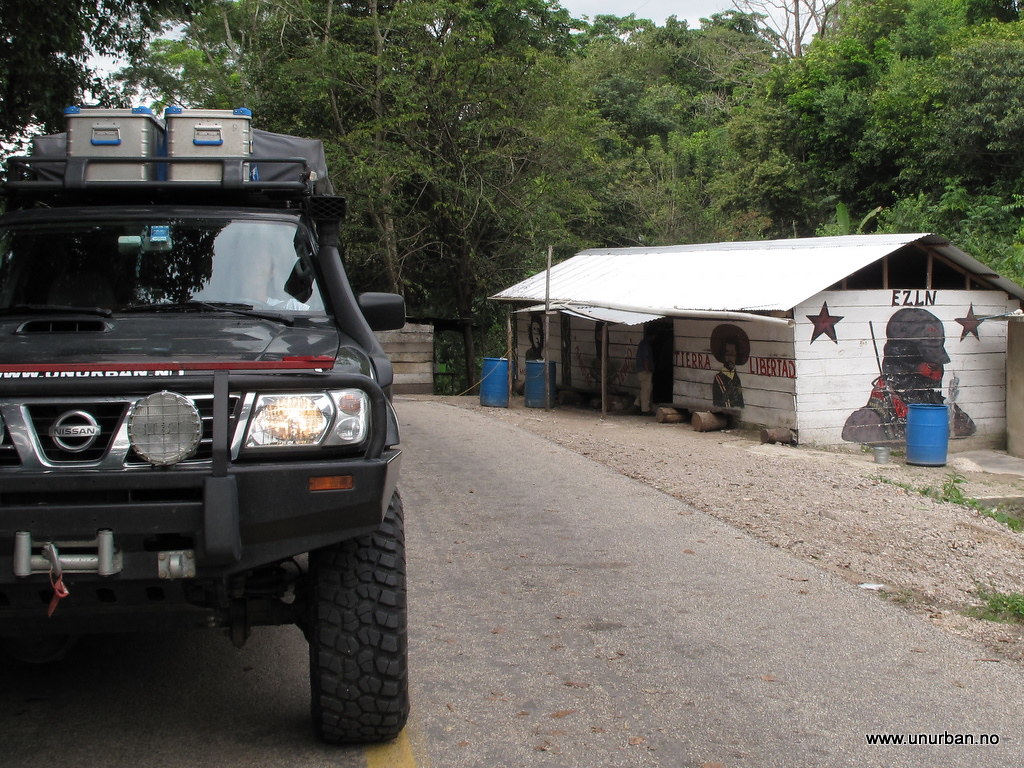
First we were stopped and had to pay 10 peso per person to the local Zapatistas, and then a bit further down the road 25 pesos per person as an entry fee for the area. And then in the end it was the boys that wanted 5 pesos to look after your car….
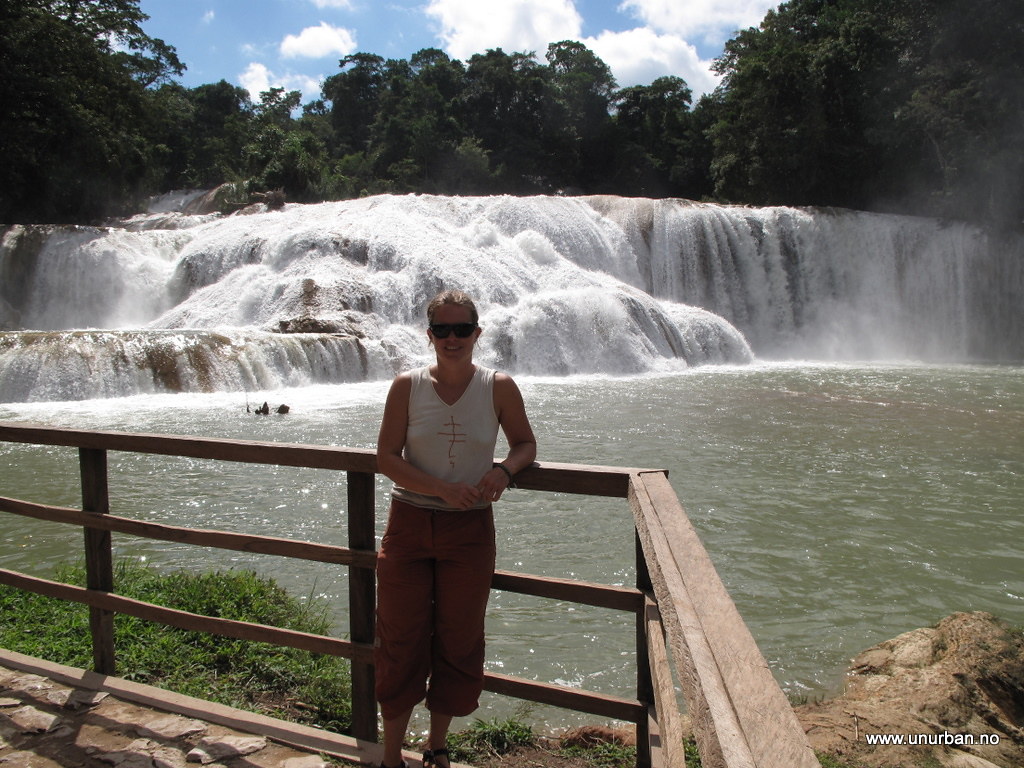
In the end we were able to have a look at the waterfalls, and they weren’t exactly azul because of all the rain, but it is a really nice waterfall and worth the stop. After a walk up to the top view point and some photos, we got some empanadas from a food stall, and continued on to San Cristobal de Las Casas.
From Agua Azul there were no more unexpected stops or fees (just an army check point). It had been a long day driving on narrow winding roads and we were pretty tired when we got to the campground. Interesting day, and now it is time to go to bed.
Goodnight!
After about a week up in the mountain we drove from Tlachichuca at 2700 meters where it was all dry and yellow, and got down on Mex 150 and continued to drive down and down. The landscape changed a lot with the altitude, and after a couple of hours driving were we at 100 meters and driving next to sugarcanes and lagoons in 34 degrees Celsius. It was amazing to suddenly be in the tropics and jungle, it was so green.
First stop in the lowlands was Catemaco in the state of Veracruz. One day we drove out to have a look at the cost at the Mexican Gulf.

There we found some really nice beaches, but the weather was gray with a drizzle. Not so good for beach life.
During the night we learnt why this area is so green. Rain, rain and a lot of rain, so the next day was a good day to leave Catemaco. We decided to drive the road on the east side of the lake and not the normal one on the west, but 40 minutes into the drive it was full stop.

Because of all the rain, a river that was not marked on our map was flowing over the river banks and a bridge. If we really had to, we could probably have crossed, but thinking about the rivers that was marked on our map further down on this road, we decided to turn around so that we wouldn’t be “trapped” between rivers. The whole drive from Catemaco to Palenque, about 460 km, it continued to rain.

In the Lonely Planet we could read that Palenque is “in an area that receives the heaviest rainfall in Mexico”.
After one more day with rain the rain god finally decided that it was enough and we could explore the Maya ruins in Palenque.

Palenque flourished from 600 to 800 AD and is known for its fine stucco bas-reliefs and inscriptions.

After exploring the nicely restored ruins,

we just had to follow a path out in the jungle to see if we could find the parts of the ruin city that are still covered by jungle.

From Palenque we wanted to drive 225 km further south in Chiapas to San Cristóbal de Las Casas. About 40 km south of Palenque we had to stop behind some cars that had stopped in the road in front of us. Then we saw that the locals, kids, teenagers, men and women, had put homemade spike roadblocks across the road in front of the cars, and they refused to remove them until a “toll” was paid. First they wanted 100 pesos to let us pass, then we saw a Mexican car paying 50 pesos and they were happy with us paying 50 pesos too. Then the spike roadblock was pulled to the side and we could pass. Chiapas style toll road….. After a few more kilometers we saw that a string was pulled across the road and we were thinking “oh no, not again”. Then we saw that a middle age women is using this trick to stop the cars to sell bananas. We did not feel the urge for bananas at this moment, so she let us pass.
We realized it was Saturday and the road between Palenque and Agua Azul is probably full of tourists so we’re guessing the locals use the opportunity to take in some extra money on the weekend. Chiapas is one of Mexico’s poorest states and about a quarter of the inhabitants are Maya. The Zapatistas are fighting for indigenous rights.
The major attraction along the road is the Agua Azul Waterfalls, and we had read that this tourist destination was run by the local people.

First we were stopped and had to pay 10 peso per person to the local Zapatistas, and then a bit further down the road 25 pesos per person as an entry fee for the area. And then in the end it was the boys that wanted 5 pesos to look after your car….

In the end we were able to have a look at the waterfalls, and they weren’t exactly azul because of all the rain, but it is a really nice waterfall and worth the stop. After a walk up to the top view point and some photos, we got some empanadas from a food stall, and continued on to San Cristobal de Las Casas.
From Agua Azul there were no more unexpected stops or fees (just an army check point). It had been a long day driving on narrow winding roads and we were pretty tired when we got to the campground. Interesting day, and now it is time to go to bed.
Goodnight!
redthies
Renaissance Redneck
Hi guys, looks like you are still having a ton of fun! great pics. I have spent so much time in Mexico and have yet to get to Guanajuato. Your pics will change that! I am now putting it on the list for the next trip south.
How are you liking the BFG KM2s now that you have some time on them? I think they will be the next tire for my Landcruiser.
How are you liking the BFG KM2s now that you have some time on them? I think they will be the next tire for my Landcruiser.
Similar threads
- Replies
- 1
- Views
- 341
- Replies
- 8
- Views
- 1K
- Replies
- 14
- Views
- 3K
- Replies
- 376
- Views
- 95K
- Replies
- 27
- Views
- 10K
